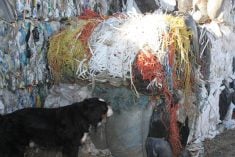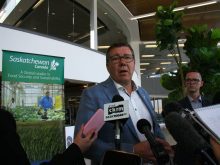This may be one of those rare years of peace and harmony between farmers and fowl.
If the clear weather holds, farmers might be able to get their crops harvested before migrating ducks and geese arrive to clean up the fields.
“If the fall keeps coming in early, it might not be a problem,” said David Marit, president of the Saskatchewan Association of Rural Municipalities. He and the SARM board toured rural Saskatchewan with Ducks Unlimited officials.
“If it starts to rain up north and guys don’t get their crops off, it definitely will be a concern, but the way it looks right now, the crop will all be off before the migration starts.”
Read Also

Alberta looks for agricultural plastic management input
Alberta provincial government giving agriculture industry a say through survey in shaping future plastics management
That’s good news for farmers because this year’s wet spring led to a rise in duck numbers, according to Ducks Unlimited. The wet spring conditions helped boost slough numbers by 13 percent, to about 4.4 million.
About 36 million breeding ducks were estimated to be active this spring on the Prairies, the North and Alaska.
Biologist Brian Hepworth, who went on the tour, said larger numbers of ducks won’t necessarily create more problems for farmers.
“The depredation problem is more a factor of a late harvest than duck numbers,” said Hepworth.
“Even in years of low duck numbers, weather is the (relevant) factor.”
Migrating ducks can be a problem for any mature crop. The birds may eat the crop, stomp about on swaths and defecate on the grain.
They are especially hard on pea crops, which fowl relish.
But with so many crops now being harvested, farmers may not have much problem at all. The harvestable grain is coming off the field and the ducks are still weeks away from migrating.
“We aren’t seeing any birds flocking up at all,” said Hepworth.
But he encouraged farmers to report problems they have because damage mitigation programs are only implemented when farmers complain. In the Wadena, Sask., area, lure crops have been planted to draw birds away from commercial crops, and DU would like to see the program expanded across the province. But that will only happen if farmers ask for it.
“The message to producers is: report where possible. Make claims where possible, because that gives us an idea where to go in the future,” said Hepworth.
“If there aren’t any issues anywhere and no reports anywhere, it can’t really be expanded.”
But Marit said he’s hoping to hear almost nothing about ducks and geese this fall.
“We’re hopeful,” he said.















